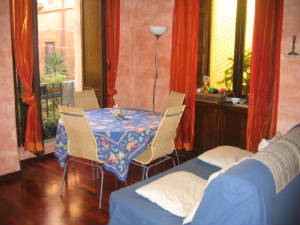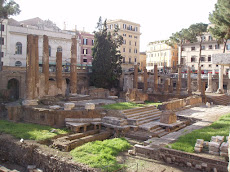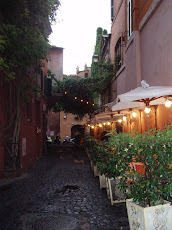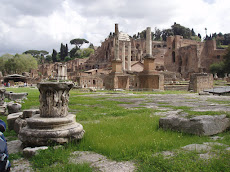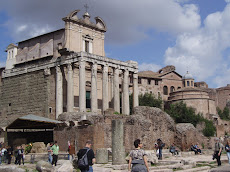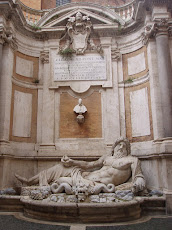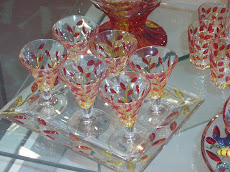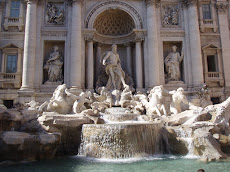


As historians and journalists will no doubt tell you, it's best to write about events soon after they happen. Time distorts and romanticises our recollections, and distills a complex memory down to its most basic outline. Sadly it was not possible for me to write about being in Rome and have the time to see Rome as well. The rest of my stay must be described from home, thus allowing me to extend my vacation as I recount how I spent it.
After keeping Dan awake much too late Sunday night I actually woke up in a fairly refreshed state on Monday morning and asked to go to the Colosseum. About this time we'd begun to shower, eat a little breakfast and go down to our local Internet cafe "Good" to hit the laptop in the mornings. Without my cell in Italy Dan's laptop was my only link to home, and I was eager to post photos on
Flickr and e-mail my family and friends. Good was run by a tiny, good-natured punk
barista who routinely wore an enormous belt stamped with the phrase "Fucking Criminal" and (other than the belt) was completely English-free. Good served espresso, rolls and freshly-squeezed blood orange juice in the morning, and a small menu of dinner items in the evening. Dan and I pounded away on the laptop until the battery went low, then we went off and had adventures.
On the way to the Colosseum we stopped for pizza, or rather for a bathroom with pizza as an polite afterthought. In Rome pizza (to go) is baked as a large
focaccia with toppings and sold by the price per kilo. This particular shop had what turned out to be my favorite variety of take-out pizza, eggplant! While waiting for our pizza to heat I went into the bathroom where I made a shocking discovery - Roman facilities are rarely graced with seats! This was found to be the case all over Rome, even in decent restaurants. Now I'm not one of those women who won't go into a public restroom without a seat cover and a can of Lysol, but I consider a toilet seat to be among the bare necessities one should expect from a crapper in the Eternal City. They also almost always provide a working sink in the bathroom, but rarely with soap or hand towels. You leave the stall with your hands dripping (or hand prints on your pants) only to find another sink in the outer bath, this time with soap and towels (if you are fortunate). Some of the restrooms are unisex, and many share a common outer chamber. My favorite was in a
Trastevere restaurant where the water in the bathroom sink was pumped by foot action on a floor pedal. How could the modern Romans, so chic in dress, so exacting about food quality and so fond of comforts be so cavalier when it came to the bath? My guess is that much can be put up with in regard to when they were able to live in such charming conditions and that sub-standard plumbing and odd arrangements are common features of historic buildings. Dan had warned me to bring antibacterial wipes and this turned out to be a smart way to go.
Other than Pompeii the Colosseum was the thing I had most been looking forward to. Until I actually saw it I thought about it as something that loomed fitfully in some collective mythology but had never really existed (as I suspect much of history is like for us Americans). Like an idiot I thought that visiting the site would make the Colosseum immediate and real and that its history would flood through me, much like the Holy Ghost shook Saint Theresa's bones. Not so much. Being able to see the thing and walk through it never lessened the sense of surrealism I felt throughout much of this trip. Here I was in Italy, something that I would never have believed a few months earlier. Historic sites in Rome are crawling with people in costumes trying to make a buck by getting into the photos of tourists, and other hawkers make a living selling junk, neatly heightening my sense of unreality. The sheer size and complexity of the Colosseum is just mind-boggling. Finally, I was surrounded by Romans who see Rome and its wonders all the time and so view them with a casual acceptance. I think subconsciously I'd expected someone to look up, step back and suddenly shout out, "Jesus Christ! It's the Colosseum!" and everyone would stop dead and their tracks in awe.
Once you enter the site of the Colosseum you travel around the outside ring of base until you take either the steps or the elevator to one of the upper decks. The elevator seemed like a good idea until I saw that it was made of clear glass and was stuffed full of tourists, and then I left Dan and headed for the steps - something I was to do many times in the days to come. At the top of the stairway I stepped out onto the second level from which you could see the entire structure. It took me some time to work up the nerve to stand near the railing, but it was well worth it, especially with the rolling clouds overhead. Since the marble had long since been removed the actual structure is evident in the internal barrel vaulting and exposed brick walls. From this level you also had a good view of the Arch of Constantine below, as well as the costumed
centurions and emperors taking a smoke break in their gear. In retrospect I should have spent some time in the lower levels where the tunnels and channels built under the floor of the Colosseum are now exposed, but we also wanted to see the Forum and Palatine. I'll do that when I come back (I have a list).
Leaving the Colosseum, one travels down a ramp into the Forum. Tourists would do well to take a look at reconstructed map of the Forum before visiting, just to get a better idea of the contents and layout. The fate of we unorganized tourists is to view the sites and then hastily buy a guide to the area to figure out what we have just seen. There are so many sites and so much history concentrated in such a small space that any casual traveler really needs to carry at least one decent guide book for reference, if not an archaeological guide as well. Dan pointed out the main features of the Forum - the Temple of Caesar, the Arch of
Septimus Severus, the Curia, and countless pieces of broken and overturned marble strewn though a grass field filled with poppies. The pools behind the Temple of Vesta were bright with wild roses and I wondered what the ancient Romans would have thought of the scene before me.
The Palatine is a hill on which the aristocracy of Rome lived dating back to the 2nd c BC was located. Under Augustus it became the area of the imperial palace and extensive construction was undertaken. Today this is a large area comprised mainly of the remnants of walls, gardens and fountain areas. The top of the Palatine is reached by ascending a fairly steep incline, but the resulting view is lovely. The Circus
Maximus is visible below, as are the wide expanses of the umbrella pines that grow all over Rome. It's odd to see the mix of pines, cypress and deciduous trees of this region, and the presence of the pines brings to mind etchings one has seen of the Roman ruins. What I assumed to be a stylized representation of a tree is actually how the umbrella pine looks. In addition, the place is lousy with acanthus, and I took several pictures for my friend Kris' benefit. Kris is an artist and often employs the acanthus motif in her work. Her website can be found at
http://homepage.mac.com/kris_gilibari/ After seeing the site Dan and visited the Palatine Museum, which is fairly small but contains some
excellent examples of the mosaics from the imperial palace.
This is probably the day Dan and I had walked more than any other while I was in Rome. We began in the morning and went until dark, so we were hungry and cranky when we stopped at a sidewalk cake for pizza and sandwiches. Unfortunately the waiter was so awful we actually got up and walked away from the meal, something I have never done before in my life. This ended up being fortuitous as we happened on a nice little restaurant close to Dan's apartment that had a great menu, cool servers and excellent prices. I had the pizza with sardines I'd vowed to have in Rome and Dan had a potato hidden entirely under a slab of proscuitto. My pizza was good but the sardines were intensely salty. The big discovery was that some diners at a nearby table ordered pizza capricciosa, with its customary quarter of hard-boiled egg replaced with a lovely, runny fried egg! On the spot we vowed to return to Cave Canem for a sample.













